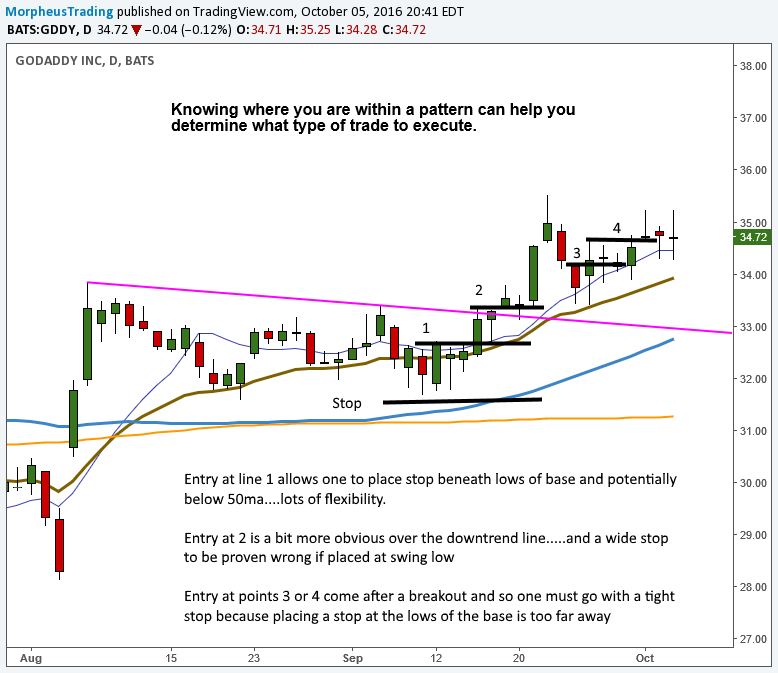
We recently bought Go Daddy ($GDDY) in our swing trading newsletter as the stock moved above the previous week’s high.
But we sold the position for a small loss of 1.4% when it hit our tight stop just two days later.
Why did we set the stop so tightly, rather than giving enough “wiggle room” to just let the swing trade play out?
The answer is because late-stage entries require tighter stops, while stop placement on earlier entries can be more loose.
Continue reading to learn a simple way to reduce your trading losses with better stop placement.
Understanding Entry Points
The overall concept to grasp is this: The higher the buy entry point of a stock, the tighter the stop price generally should be.
This is because a higher entry point is typically further away from key support of a swing low, which increases risk.
This means you need to have a basic understanding of how to identify the level of your entry point on a stock chart.
The annotated daily chart of $GDDY below explains how to do so in a simple way:

Entry 1 — If entering this stock at this level (around $32.70), a stop can be placed below the lows of the base (as labeled). This stop price is great because it forces the stock to make a new low within the base in order to prove the entry wrong. In other words, you definitely want to be out of the trade if this stop is triggered.
Entry 2 — The same stop price could be used with entry 2, although the distance to the stop price is wider (slightly higher risk). A buy entry at this level is a bit more obvious, which sometimes creates false breakouts.
Entry 3 — A buy entry at point 3 would occur when buying a pullback after a breakout. In this case, you should set a stop beneath the previous swing low (~ $33) because a stop below the low of the original base would now be 8-15% away (depending on stock’s volatility).
Entry 4 — If buying at entry point 4 (second move up after the base breakout), your stop could also be placed beneath the previous swing low (which is now at a higher price). These sort of entries should move higher swiftly (be right or be right out). If there is no immediate follow-through to the upside, selling right away is an option. The challenge with these late-stage entries is that you may need to take a few shots before getting it right.
 Go Daddy! (Except It Didn’t)
Go Daddy! (Except It Didn’t)
When we bought shares of $GDDY in our model portfolio at $35.08 on October 3, it was obviously at “Entry 4” on the chart.
The immediate lack of bullish follow-through is why we decided to sell at $34.60 on October 5.
Such quick action limited our loss to just 1.4% and minimized risk.
Furthermore, we continued to hold the shares from our original September 27 entry of $34.01 (Entry 3).
With a better entry price, there was less risk of holding the Entry 3 trade at that time.
Summary Of Stop Placement Strategy
While many nuances can be at play when reading stock charts, the main takeaway from this article is:
The lower the buy entry within a base, the more patient you can be. The higher the entry, the less patient you can afford to be.
If you cannot set a stop price below a significant low because it is 10-15% lower than the current price, then it is better to use a tight stop of 3-5% instead.
If our entry into $GDDY would have been closer to $33, we could have stayed with the full position as it chopped around the breakout point at $34.
However, since we initiated our position around $34 and added to the position at $35, the lack of follow-through forced us to exit (the additional shares) with a small loss.
Remember that volume should also confirm breakouts, especially when buying stocks at Entry 3 or Entry 4.
Finally, the overall health of the market should also be considered when setting stops.
If the market is in moonshot rally mode, buying a stock at a higher entry point within the base will often work.
But when conditions are choppy, it is often better to be more creative by entering near the low of a base, setting your stop below the base.
“Set it and forget it” is an excellent approach to stop placement we use in our swing trading service when buying at Entry 1 or 2.
What did you think of this article? Want more of the same? Please share your comments below.
